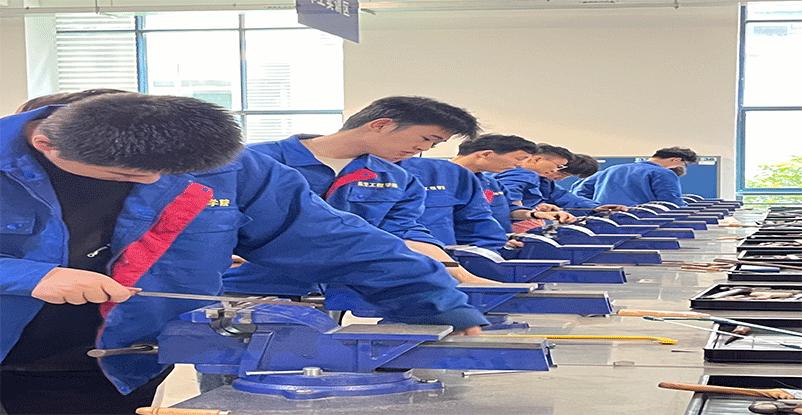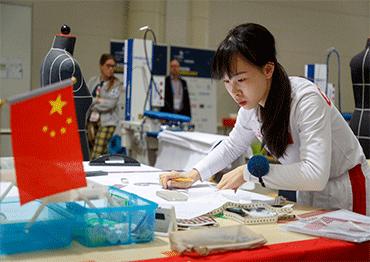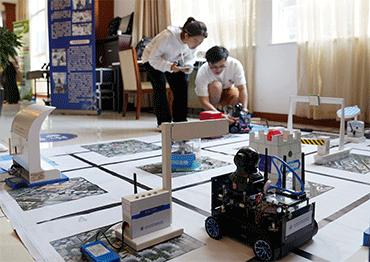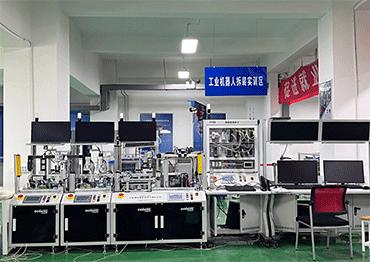Lian Fei, enrollment director of Nanjing Vocational University of Industry Technology (NVUIT), found that enterprises are increasingly willing to employ their graduates. “They’ve given us good feedback about our graduates they employed and nearly 100 percent of the employers want to hire the next cohort,” Lian told NewsChina. “This year, some enterprises told me in advance that they want to employ the next batch of graduates with a undergraduate degree.”
A former ordinary vocational college in Jiangsu Province, NVUIT received approval to become a vocational university offering degrees at the end of 2019, the first such higher vocational school in China. In 2022 when the school’s first cohort of students that shifted from two-year associate diploma courses to four-year degree courses graduated, the school had to work to ensure businesses knew about their graduates. Two years later, businesses came seeking new employees.
Lian attributes the change to the increased need for professionals trained in advanced technologies. This year, the school added three new degree courses in engineering disciplines. Enrollment has expanded every year and the minimum score students need to have attained to get a college place from the entrance examination keeps rising.
“Our minimum entry score has exceeded all the private [general] universities in Jiangsu and even some second-level public colleges and universities,” Lian said. “This year, we plan to enroll about 6,700 students for undergraduate degrees, which includes candidates who sat the national college entrance exam and the exam for vocational high school students, as well as those already holding an associate diploma,” he added.
In 2014, China’s State Council first proposed that vocational colleges should be allowed to offer degrees. The same year, an MoE official told media that the shift for general universities to focus on more practical technology or engineering courses is crucial to ensure there is a good system of training skilled professionals across many industries.
However, in an article published in the Journal of National Academy of Education Administration in October 2022, Wang Xuchu, who has a doctorate in education from South China Normal University, and former president of Sun Yat-sen University Huang Daren pointed out that universities are often reluctant to switch gear toward vocational courses, as they fear discrimination after being labeled an institution for vocational education. This is why vocational colleges themselves led the reform.
In May 2019, the MoE approved the first batch of vocational schools to offer degrees.
Sun Cheng, former director of the Institute of Vocational and Continuing Education, National Academy of Educational Sciences, believes that the move for universities to offer more practical courses and vocational schools upgrading to offer degrees aims to emphasize the integration of industries and education, increase cooperation between schools and enterprises and improve graduates’ competitiveness.
“Our research found the MoE’s reform was largely driven by external forces, I mean, the development of industrial digitization and smart technologies,” Kuang Ying, a professor at the Institute of Vocational & Adult Education, East China Normal University, told NewsChina, adding that many sectors such as agriculture, manufacturing and services have seen significant changes in their need for talent. For example, with the rise in pet ownership, vocational schools, which offer pet-related courses under the wider discipline of animal husbandry, are seeing greater demand for trained professionals knowledge-able in pet nutrition and veterinary medicine. Meanwhile, manufacturing now requires staff who can master mechanics and technology theory with improved ability to judge and handle complex situations.
“Along with the development of new quality productive forces, Chinese enterprises will definitely have higher demand for highly skilled interdisciplinary talent for emerging strategic industries and future new industries, so we’ll see more vocational colleges offering degrees and more flexible majors,” she said.
Wang Hongjun, former director of NVUIT’s teaching affairs office, told NewsChina that in the past, graduates from vocational colleges were likely employed as manual laborers with little chance of promotion. Now vocational school graduates with a degree are employed in design and technological posts, and can even enter a management career track.

 Old Version
Old Version






